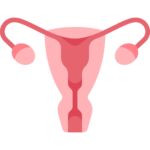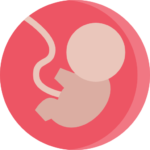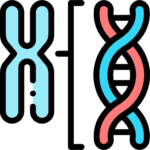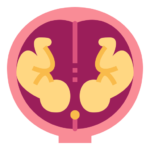
Fetal Anomalies
Cervix
Incompetent Cervix
Patient had a “routine” ultrasound to evaluate fetus at 20 wks gestation. Do to suspicion of cervical dilatation on initial scan (left image), patient was brought back the following day and the second image (right) was obtained. The patient was taken to the O.R. for an emergency cerclage. She delivered at term.
Endovaginal and Perineal Evaluation
Endovaginal and perineal ultrasound are usually performed with an empty bladder. Visualize the cervix in a sagittal plan. It is usually easiest to first identify the internal cervical os, then adjust the probe until the entire cervical canal is visualized. The external os may be difficult to see, but can be identified by following the curve of the posterior lip of the cervix to its intrsection with the cervical canal. Gradually relax pressure on the transducer until the image becomes slightly blurred. Reapply gentle pressure sufficient to establish a sharp cervical image. The length of the closed cervical canal is measured. Funneling of the upper cervical canal, if present is not included in the measurement of cervical length. Funneling may indicate incompetent cervix (depending on gestational age, obstetric history and clinical circumstances).
Perineal scanning is performed with a standard curvilinear probe, covered with a glove and applied to the perineum using a large amount of gel. Place the probe gently between the labia and adjust to get a clear image of the cervix. Perineal scanning is more difficult to learn than endovaginal scanning. The vagina curves and there is frequently shadowing from the pubic bone and from stool in the rectum. Moving the probe slightly to the side or up or down may improve the visualization.

I use a slightly different nomenclature when measuring cervix after a cerclage.

Perineal scanning is more difficult to learn than endovaginal scanning. The vagina curves and there is frequently shadowing from the pubic bone and from stool in the rectum. Moving the probe slightly to the side or up or down may improve the visualization. With practice, perineal images can approach endovaginal scans for accuracy in measuring the cervix.
Placenta
Outline
- Placenta Previa
- Complete previa
- Marginal/Partial previa
- Vasa Previa
- Placenta Accreta / Increta / Percreta
- Polyhydramnios (especially note the presence, or absence, of stomach bubble)
- Excess production
- Diabetes
- Macrosomia
- Decreased swallowing
- CNS abnormality (aneuploidy, hydrocephalus, viral infection)
- Esophageal atresia
- T-E fistula
- Excess production
- Oligohydramnios
- Loss (PROM)
- Decreased Urination
- Obstruction
- Kidney
- Ureter
- Bladder
- Decreased urine production
- Obstruction
- Absent kidneys (renal agenesis)
Placenta Previa
Placenta previa occurs when the placenta covers the internal cervical os. Placenta previa occurs in 1/200 to 1/300 pregnancies. The risk of previa increases with increasing parity. Placenta previa should be suspected in any case of second or third trimester bleeding; in particular, previa is associated with painless vaginal bleeding.
Placenta previa is defined by the location of the placenta relative to the internal cervical os. Remember that these definitions were made by digital exams (under double setup conditions) in patients with a cervix dilated 3–4 cm. The definitions of marginal vs. partial previa are of questionable value in patients identified by ultrasound with a closed cervix.
Complete (or total) previa: The placenta completely covers the internal cervical os.
Partial previa: The placenta partially covers the cervical os.
Margina previa: The placental edge is at the edge of the internal cervical os.
Low-lying placenta: The placenta edge is in close proximity to the internal cervical os. By vaginal ultrasound, this is usually defined as a placental edge < 2 cm from the internal cervical os.
Vasa Previa
Vasa previa is best confirmed by endovaginal ultrasound. In this case, endovaginal scan demonstrated fetal vessels coursing over the internal cervical os. Vasa previa can be confusing, as a free loop of cord near the cervix may mimic a vasa previa. I try to identify the placental insertion of the umbilical cord to exclude a vasa previa. In this case the vessels inserted into the lower edge of the placenta, then coursed over the internal cervical os (placenta is low-lying). The clinical pictures as the bottom show the umbilical cord/vessel insertion into the placenta.
CNS / Spine
- Absent cranium
- Defect in cranium
- Absent cavum septum pellucidum
- Abnormal ventricles
- hydrocephalus
- holoprosencephaly
- agenesis of corpus callosum
- schizencephaly
- Abnormal cerebellum
- Neural tube defect (spina bifida) , 3D / (Case 2, with MRI)
- Mass
- arachnoid cyst
- sacrococcygeal teratoma
- Abnormal angulation
- limb-body wall complex
- Other abnormalities
- caudal regression
Anencephaly
Exencephaly and Extrathoracic Heart Amniotic Band Syndrome
Exencephaly = acrania
22 y/o G1 P0
EGA 17 wks
Referred due to abnormal ultrasound
Exencephaly (sometimes called acrania) results from failure of the calvarium to develop. It is often (as in this case) due to amniotic band syndrome. If not recognized in early pregnancy, brain tissue may resorb resulting in the appearance of anencephaly. In this case, recurrence is very unlikely as this was due to amniotic band syndrome, a sporadic event.
Anencephaly and Rachischisis Craniorachischisis Cranial Spinal Rachischisis
Initially this was thought to be a possible exencephaly, due to appearance of tissue above the maldeveloped cranial cavity. Autopsy showed only vascular tissues and membrane, confirming anencephaly. Different texts use slightly different terminology to describe this variant of anencephaly.
Encephalocele
Encephalocele is characterized by herniation of intracranial contents through a defect in the skull. The defect may be anywhere in the midline of the skull, but the majority are occipital. The degree of herniation ranges from meniges and fluid to varying amounts of brain tissue (even including the lateral ventricles). Encephaloceles are often associated with other anomalies (for example, Meckel-Gruber syndrome, an autosomal recessive condition, has polycystic kidneys, polydactyly, cleft lip and encephalocele).
Even isolated encephaloceles are often associated with poor neurological outcome, due to neuronal migration defects in the brain.
Holoprosencephaly (alobar)
Holoprosencephaly results from a failure or midline cleavage of the forebrain. Holoprosencephaly may be alobar, semilobar or lobar. Holoprosencephaly is often associated with Trisomy 13. Autosomal recessive and autosomal dominant forms have also been reported.
The cases shown here are alobar holoprosencephaly. There is a single ventricle anteriorly (first and second images). The cavum septum pellucidum is absent. The thalami are fused (second and third images). The cerebellum may appear normal (fourth image).
Agenesis of the Corpus Callosum
The corpus callosum is an interhemispheric pathway. The majority of cases of agenesis of the corpus callosum (ACC) have other associated CNS anomalies. Approximately 85% of people with isolated agenesis of the corpus callosum are aymptomatic.

Ultrasound images show narrowing of the frontal horn and dilatation of the occipital horn of the lateral ventricle. There is also dilatation of the third ventricle. The cerebellum and cisterna magna appeared normal in this case of isolated ACC.
Ultrasound texts describe specific visualization of the corpus callosum, but I have not found this to be reproducible.
Schizencephaly
Schizencephaly is the presence of clefts within the substance of the brain. Pathologic examination shows that the clefts are line with grey-matter. Neurologic impairment is reported to depend on the degree of cerebral mantle involvement.
encephalocele with associated Dandy-Walker malformation
A case of encephalocele with associated Dandy-Walker malformation. As there is no brain tissue in the protruding sac, this may be better identified as a cranial meningocele.
Lumbar Spina Bifida Case 1
Patient was referred due to finding of ventriculomegaly (noted in scan at right). Additional findings included scalloping of the frontal bones (“lemon sign”), second row left, and obliteration of the cisterna magna and compression of the cerebellum (“banana sign”), second row right. Serial transverse images of the spine (third row left) show the splayed laminae in the lumbar region. The defect can also be seen on long axis transverse view of the spine (third row right).
Lumbar Spina Bifida Case 2
MRI images of neural tube defect. First row shows long axis images, sagittal (left) and coronal (right), demonstrating Chiari II malformation. Second set shows a series of transverse images demonstrating the lumbar neural tube defect in images 7 through 9.
Neural Tube Defect (3D)
Genitalia
Ambiguous genitalia
Bladder
- Absent bladder – confirm expected bladder position by identifying umbilical arteries with color flow doppler
- renal agenesis
- infantile polycystic kidney disease
- Bladder outlet obstruction
- Other
- ectopic ureterocele
- bladder extrophy
Cord Insertion / Abdominal Wall
- Abdominal wall defect
- omphalocele
- gastroschisis
- pentalogy of Cantrell (includes ectopia cordis)
- Two vessel cord – associated with increased risk of cardiac or renal anomalies
Omphalocele
Omphalocele identified at 15 wks EGA. Amniocentesis revealed this case to be a Trisomy 13. Color doppler shows that the umbilical cord inserts into the membrane covered mass rather than beside it (although it’s not easy to see at this early GA).
A “physiologic” omphalocele may be noted prior to 11-12 weeks gestation. The intestine initially develops outside the abdominal wall and retracts into the abdomen at about 10.5 weeks EGA. This is demonstrated in the following two scans (of the same patient) at 10 and 11 weeks EGA.
This massive omphalocele was part of a limb-body-wall complex. The anomaly occurred in a twin gestation; twin A was normal.
Gastroschisis
Gastroschisis is an abdominal wall defect, usually right paramedian, resulting in bowel freely floating in the amniotic cavity. It is more common in women <20 y/o and may be associated with smoking and drug use. Gastroschisis is differentiated from omphalocele by the absence of a membrane containing the herniated bowel. Unlike omphalocele, gastroschisis is rarely associated with other anomalys or with chromosomal aneuploidies; however, a ruptured omphalocele may appear similar to a gastroschisis. Fetuses with gastroschisis are frequently growth restricted and are at increased risk of intrauterine fetal demise.
Route of delivery is controversial – there is no substantial published evidence to suggest that outcomes are better with cesarean delivery, but cesarean delivery is frequently recommended due to concern for protecting the bowel.
Pentalogy of Cantrell
Other findings may include neural tube defects, facial defects, clubbed feet, cardiac defect (tetralogy of Fallot). This anomaly is almost always lethal. The etiology is not clear but this anomaly seems to be part of a spectrum of complex anomalies involving disruption of the body wall (see Limb-Body-Wall complex). They are sometimes also called body stalk anomalies. The first sonographic clue may be a large omphalocele; often these fetuses have so many anomalies that the picture is very confusing. It’s important to work systematically through each system to identify the structures and the abnormalities.
- ectopia cordis (extrathoracic heart)
- omphalocele (specifically an epigastric omphalocele)
- disruption of distal sternum
- diaphragmatic defect
- pericardial defect(Cantrell, 1958)
The clinical pictures demonstrate the multiple, and somewhat confusing, complex of anomalies. Note that the umbilical cord is essentially absent with the umbilical region connected to the placenta. Intestine and liver are out of the abdominal cavity. The lower extremities are malpositioned. There is a large meningocele. The heart is extrathroacic, although it is covered by a membrane. There was some debate as to whether to call this a pentalogy of Cantrell or a Limb-Body-Wall complex.
Limb-Body-Wall Complex (Body Stalk Anomaly) (Amnion Rupture Sequence)
Kidneys
- Absence (renal agenesis) – bilateral or unilateral
- Obstruction
- uretero-pelvic junction (UPJ)
- ureteral
- ectopic ureterocele
- bladder outlet obstruction (posterior urethral valve in male)
- Pyelectasis (dilated renal pelvis)
- aneuploidy
- obstruction
- Abnormal morphology
- multicystic dysplastic kidney
- polycystic kidney disease
- Prune-belly syndrome
Renal Agenesis (Bilateral)
Bilateral renal agenesis, sometimes called Potter’s Syndrome, is a complete failure of development of the kidneys. It is suspected when there is severe, or absolute, oligohydramnios (anhydramnios). It is important to differentiate from premature rupture of membranes and from other renal abnormalities that result in severe oligohydramnios (such as infantile polycystic kidneys).
Bilateral renal agenesis is lethal due to oligohydramnios sequence—pulmonary hypoplasia, dysmorphic facial features (flat nose, low set ears), and limb deformities. It may not be diagnosed until well into the second trimester, as amniotic fluid is generated by skin transudation until second trimester, when fetal urine production is the primary source of amniotic fluid. Most cases are sporadic, so the risk of recurrence is low.
Renal agenesis may be associated with other fetal anomalies such as VATER or VACTERL.
Renal Collecting System Dilatation Pyelectasis, Hydronephrosis
- Case 1
- Case 2
- Case 3
Stomach
- Absent stomach (especially if associated with polyhydramnios)
- esophageal atresia or T-E fistula
- Excessively large stomach (“double-bubble”)
- duodenal atresia
- Abnormal location
- diaphragmatic hernia
- situs inversus
- polysplenia/asplenia
Diaphragmatic Hernia
Diaphragmatic hernia is a defect in the diaphragm that allows abdominal contents to herniate into the chest. Left sided, posterolateral defects are most common, but the defect can occur anywhere. Diaphragmatic hernia results in compression of the lung, often leading to pulmonary hypoplasia. 1/3 to 1/2 of fetuses with diaphragmatic hernia have other associated anomalies and chromosome abnormalities are common. Survival of infants with diaphragmatic hernia is reported as anywhere from 50% to 80%, depending on the location of the hernia, presence of poor prognostic factors and postnatal treatment. In-utero surgery for diaphragmatic hernia has been described. Poor prognostic factors include herniation of liver into the chest, polyhydramnios and effusions.
Diaphragmatic hernia in Twin B at 22 weeks EGA. Note the stomach in the same picture as the 4 chamber heart view. On long axis stomach and intestine herniate through the diaphragm into the chest. The heart is moved into the right side of the chest (dextrocardia).
Diaphragmatic hernia at 29 weeks EGA
Heart / Lung
- Abnormal position
- pleural effusion
- pulmonary mass effect
- diaphragmatic hernia
- cystic adenomatoid malformation (CAM)
- eventration
- ectopia cordis (also found in pentalogy of Cantrell)
- Abnormal axis
- dextrocardia, situs inversus
- Abnormal 4 chamber view
- Abnormal outflow tracts
- Abnormal rhythm
- premature atrial contractions
- tachycardia
- bradycardia
- Pericardial effusion (component of hydrops)
- isoimmunization
- viral infection
- Lung
- Cystic Adenomatoid Malformation
- Diaphragmatic hernia / eventration
- Pleural effusion
Face
- Cleft lip
- Hypertelorism
- Hypotelorism
Extremities
- Skeletal dysplasia
- Polydactyly
- Clubfoot
Polydactyly
Polydactyly may occur as an isolated autosomal dominant disorder (more common in African-Americans), but most cases that are sonographically identified are associated with other anomalies. Trisomy 13 is the most common chromosome aneuploidy associated with polydactyly.
- Case 1
- Case 2

This case was associated with a Dandy-Walker malformation.
Clubfoot
Isolated clubfoot. Clubfoot may be associated with a wide variety of conditions, including chromosome aneuploidy.
Other
- Amniotic Band Syndrome (also see Amniotic Sheets)
- Hydrops
Aneuploidy
- Sonographic Markers of Aneuploidy
- First Trimester: Nuchal Translucency
- Examples of aneuploidy:
46, XY, der(13)t(3;13)(q11.2;p11.2) – Unbalanced translocation with monosomy 13p and trisomy 3q
Second Trimester Markers of Aneuploidy*
- Nuchal thickening (>5 mm — Likelihood ratio for Down Syndrome 25x)
- Cardiac anomalies (increased risk – varies with anomaly observed)
- Femur length (<0.91 of expected — Likelihood ratio for Down Syndrome 2.2x)
- Humerus length (<0.89 of expected — Likelihood ratio for Down Syndrome 2.5x)
- Renal pyelectasis (>3 mm AP diameter — Likelihood ratio for Down Syndrome 1.6x)
- Echogenic bowel (echogenicity matches iliac wing — Likelihood ratio for Down Syndrome 5.5x)
- Echogenic intracardiac focus (discrete bright focus within the heart — Likelihood ratio for Down Syndrome 2x)*Likelihood ratios for Down Syndrome from Nyberg DA, et al, Ultrasound Obstet Gynecol 1998; 12:8-14
Occasional Findings associated with aneuploidy
- Choroid Plexus Cysts (1-3% risk if large, bilateral & persistent – Trisomy 18, also Trisomy 21)
- Clinodactyly (? risk)
- Double bubble (duodenal atresia)
- Cystic hygroma (approximately 30% will have aneuploidy)
- Pleural effusion
- Ascites
Second Trimester Markers
Occasional findings in cases of aneuploidy
Nuchal Translucency
First Trimester Aneuploidy Screening
Aneuploidy Unbalanced Translocation 46, XY, der(13)t(3;13)(q11.2;p11.2)
Unbalanced chromosome rearrangement, with a derivative chromosome 13 in all cells examined. This chromosome appears to be derived from a translocation involving the long arm of one chromosome 3 and the short arm of one chromosome 13, resulting in partial monosomy for 13p and partial trisomy for 3q.
Monosomy for 13p is not expected to be clinically significant. Trisomy 3q in one reported case had severe brain and cardiac malformations, renal abnormalities, omphalocele, and neonatal death.
Maternal
- Uterine anomalies
- Septa / Amniotic sheets / Synechiae (also see Amniotic Band Syndrome)
- Adnexal masses
Multiple Pregnancy
- Monoamniotic twins
- Twin-twin transfusion syndrome
- Conjoined twins
Multiple Pregnancy
An effort should be made to distinguish the type of twinning (monozygotic or dizygotic) as monozygotic twins have an increased risk of specific complications, such as twin-twin transfusion syndrome. Many high-order multiple pregnancies result from assisted reproductive technologies (ovulation induction, IVF, etc.), but dizygotic twinning still may occur. The best time to identify the type of membranes (dichorionic, diamnionic or monochorionic, diamnionic) is probably in late first trimester.
Unusual twinning situations:
- Monoamniotic twins
- Twin-twin transfusion syndrome
- Conjoined twins
































































































































































































